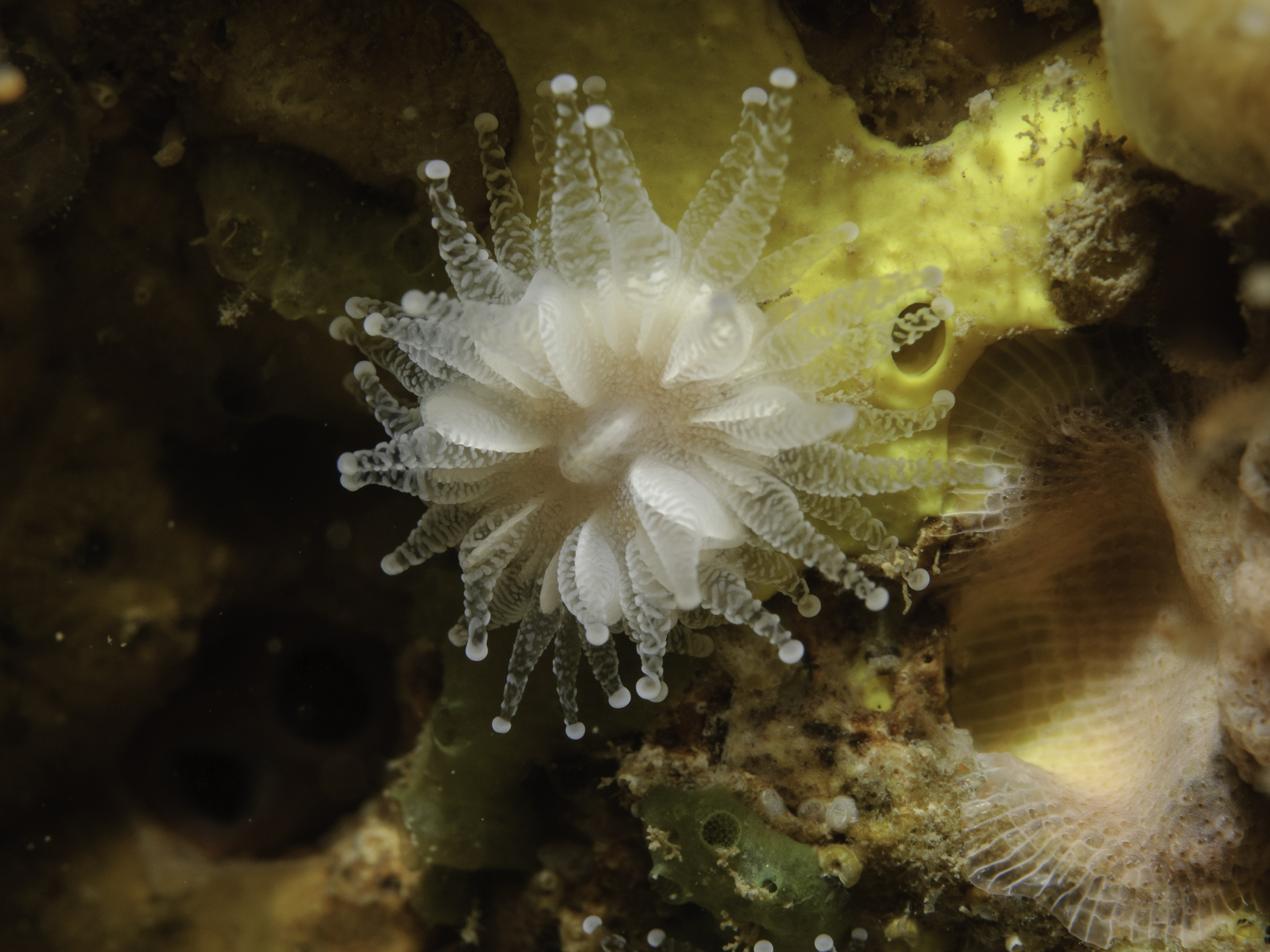Northern Ireland Priority species (NIPS)
| CNIDARIA : Scleractinia : Caryophylliidae | SEA ANEMONES AND HYDROIDS |
Caryophyllia inornata Duncan, 1878
 |
| Caryophyllia inornata |
A rare species of cup coral, found on bedrock gullies and caves; known from one site only in Northern Ireland.
In brief
- Found only on Rathlin Island
- Habitat is bedrock, vertical faces, overhangs and caves, frequently in poorly lit locations
- Can be found throughout the year
- It is an extremely rare species, exploiting a specialised habitat
- Trends in its conservation status are not known.
Species description: This is a relatively inconspicuous cup coral, up to 12mm across and up to 18mm tall — its height is typically greater than its diameter. It has a robust calcareous skeleton for its size, characterised by protruding septa or divisions which extend outside the top of the skeleton. The polyps are translucent white with short knobbed tentacles, although some writers also report colours ranging to pale reddish-brown.
Life cycle: The species is dioecious, that is, there are two distinct sexes, and after spawning and fertilisation, there is a relatively long planktonic stage, thus allowing quite wide dispersal of larvae. This has not, however, prevented it from being extremely localised.
Similar species: Corynactis viridis, the jewelled anemone is superficially similar, but has a much wider range of colours. Caryophyllia smithii, the Devonshire cup coral is also similar, but C. inornata is smaller, and septa are in six-rayed formation.
How to see this species: Caryophyllia inornata may be found on sublittoral (down to about 30m depth) vertical or overhanging rock faces, and even small caves — notably locations with greatly reduced light, and often in small groups. The only known Northern Ireland site is off Ruecallan, Rathlin Island. The species has also been recorded in Lough Hyne, Cork, and in western Scotland and south-west Wales and England. Further afield, it is commonly recorded from Azores and along the Atlantic coasts of Spain, Portugal and France. It can be found throughout the year.
Current status: Known only from Ruecallan, on Rathlin Island, and this is one of only two localities in Ireland.
Why is this species a priority in Northern Ireland? Northern Ireland holds one of the only two known sites for this species in Ireland, and is rare, probably declining. It is a characteristic species of very unusual sublittoral cliffs and cave systems around the western end of Rathlin Island.
Threats: There are no known threats, and its habitat may be regarded as being fairly immune to human disturbance or damage. However, despite this it may be vulnerable to ecosystem changes brought about by changes in water quality, and by climate change, although it is equally possible that its range may increase with warming sea temperatures.
Distribution Map from NBN: Caryophyllia inornata at National Biodiversity Network mapping facility, data for UK.
iNaturalist: Caryophyllia inornata at iNaturalist World Species Observations database.
WoRMS: Caryophyllia inornata at World Register of Marine Species. Accepted name: Caryophyllia (Caryophyllia) inornata (Duncan, 1878). AphiaID: 135141.
Classification: Biota; Animalia; Cnidaria; Anthozoa; Hexacorallia; Scleractinia; Vacatina; Caryophylliidae; Caryophyllia
| Previous species | Next species |
| Authors (2024). Caryophyllia inornata. Duncan, 1878. [In] Priority species, Marine Biodiversity Portal NI. https://www2.habitas.org.uk/marbiop-ni/priorityaccounts.php?item=D13710. Accessed on 2025-04-20 |